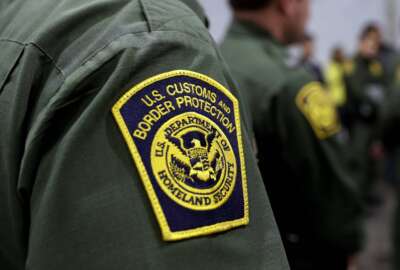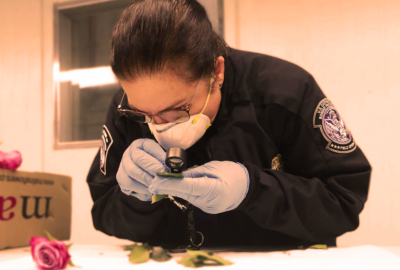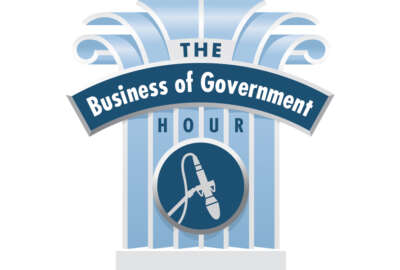This senior executive is all about effective acquisition with finesse
Like every agency, Customs and Border Protection (CBP) relies on its acquisition workforce to keep it supplied. In the ongoing crisis at the U.S. southern border,...
Like every agency, Customs and Border Protection (CBP) relies on its acquisition workforce to keep it supplied. In the ongoing crisis at the U.S. southern border, CBP appears to have a secret weapon in the person of its assistant commissioner for the office of acquisition. This long-serving official has received a Presidential Rank Award. The Federal Drive with Tom Temin talked with Diane Sahakian.
Interview Transcript:
Tom Temin You’re excited about procurement and acquisition. Tell us more about what you actually do there and how you support the mission.
Diane Sahakian Well, first of all, I’m dual hatted. I’m also the head of the contracting activity. It was attached to the job that I had recently been promoted from. And pretty soon that will go to somebody else. But pretty much for the last eight years or so, I have been the head of contracting activity for CBP. And if anybody follows the news, there’s a lot of action at CBP. And I’ve always said I think we’re probably the most, one of the most, I’ll say, responsive and hard charging procurement shops in government just to keep up everything that we know that is going on. It seems more going up than going down these days.
Tom Temin What are the types of things, supplies and so forth that are most needed? As you know, CBP deals with the border.
Diane Sahakian I would say the biggest challenge is the transportation, essentially moving the noncitizens around, like moving them around to where we can take proper care of them because it’s all about the humanity. These are people. Maybe they aren’t supposed to be coming, but they’re here and we need to treat them as such. That means you have to have the proper hygiene items, nothing extravagant, but just enough to keep sicknesses at bay and to make sure the children are well cared for. But pretty much now, since we have so many, it’s really moving them to where we can process them quicker and better. So it’s a lot of kind of every week it’s a different thing. We’ve been setting up some more facilities. These are sort of temporary facilities for them and it’s all so that we can get them properly processed and documented before they get to the next stage of the process, because CBP really is only supposed to have people. I mean, ideally a day would be great, but I think the limit is like 72 hours. That time could be breached really quickly if people start backing up. So the goal is just moving people out. So I would say transportation, temporary housing and just the food, the necessities.
Tom Temin It’s a very variable situation and it’s hard to predict demand signals like you can for something steady, like ammunition over the course of a year or uniforms over the course of a year, that kind of thing.
Diane Sahakian And we do all that, too. That’s what’s the challenge, is the unpredictability.
Tom Temin And so what are some of the strategies you have to be able to not get into an anti deficiency situation and yet keep people supplied with what they need? It could be 6,000 people this week, 2,000 the next week and 10,000 the week after that.
Diane Sahakian Well, we use every flexibility available to us in the acquisition regulations. But that being said, we do get ahead of things. We set up contractual vehicles, basically blanket purchase agreements, for example, emergency supplies and services, which those folks know how to deploy quickly. We can do a quick run off competition and get things. These are like the hand-washing stations and the port of johns and snacks and things like that, little kitchen setups and so on, so forth, if we need it. So I think that has saved us on many occasions because we have it. Also, our partners at the department have awarded large strategic contracts for the temporary shelters and so on, so forth. So we can do quick runoffs on those vehicles, too. So there’s a lot of I’ll say. And then there’s good old [General Services Administration (GSA)]. We love GSA. So we use vehicles that are already in existence and we compete as much as we possibly can. A matter of fact, in CBP, we surpassed I think we almost did, 74% competition last year. $7 billion. That’s a lot of competition. Even with all this going on. So I think we’ve figured out how to compete. Most of this stuff quickly.
Tom Temin We were speaking with Diane Sahakian. She’s assistant commissioner for the Office of Acquisition at Customs and Border Protection and a Presidential Rank award winner this year. Just maybe for those that are not involved in this type of thing day by day. You mentioned there’s the acquisition function and the contracting function. They’re related in the same way that finance and accounting are related. Maybe explain the interplay and where does the competitive outreach take place? Acquisition or contracting?
Diane Sahakian I think contracting, which we call procurement that’s the name we use at CBP. So procurement is a subset of acquisition in the CBP world, and they’re kind of hand-in-hand. There are a lot of programs that require all sorts of, I’ll say, gate reviews at the department level because they’re big dollar. We’re talking hundreds of millions of dollars. Big things that last for a couple of years that require all kinds of tests and evaluation and alternative reviews. Those are acquisitions. They are also procurements because you have to buy them, but they have to go through a whole nother set of rules. But there’s tons of procurements that aren’t in the acquisition lifecycle because they don’t need to be, because they’re under like 300 million or whatever the dollar of the day is. So we do a lot of stuff in the sweet spot of under a couple of hundred million. We do a lot of stuff under 100 million. We do a lot of stuff under a million. We just do all kinds of stuff.
Tom Temin It sounds like you’re pretty enthusiastic about this function. You have been doing it a long time. Give us the quick bio of your career.
Diane Sahakian I started off in private industry for just a couple of years, of all things as a contract administrator in court reporting, which is one of the most cutthroat businesses I ever could imagine. I got out of there and I joined the Customs Service, my first procurement. I came in as a GS-9. It was a P-3 airborne early warning aircraft. And my boss said to me, this is easy. It’s a sole source with Lockheed. You can do it. Well, then we bought like eight of them. So that sort of shaped my career. First ten years of my career was all in air, marine flying aircraft, helicopters and all the support. And then I sort of started moving around. And then my big change came when the Department of Homeland Security was set up in 2003 and Air Marine went to somewhere else and I didn’t have anything to do. And I said, How about I handle the Border Patrol? And that’s where things started to change for me in terms of really being able to make a difference and see a wonderful organization that kind of never really had the support they needed before, now have an opportunity to really do what the Border Patrol needed, in terms of raising the warrant levels of people out there and making sure the training was up to speed, getting them the things they need when they need them. We’re talking every week. You have to buy fuel. You have to buy food all the time. It was a whole nother ballgame. I learned quite a bit. So I would say that I feel like a whole new job when the Department of Homeland Security set up. I was going to leave government. but somebody said, you should just stay it’s going to change anyway. And it did, all for good.
Tom Temin And so that brings up the question of something you probably have learned to do well over the years, and that’s balance. The topical need, the variable need, the emergency need, say. And as we discussed in the case of the border versus the long term sustainment and capital types of acquisitions so that people aren’t driven crazy, but yet you don’t neglect the long term because of the need to focus on the short term. How do you handle that one?
Diane Sahakian That’s a tricky one. So we realized, my deputy and I realized about two years ago that just keeping the lights on at CBP is about 4 billion a year. Just the IT running, everything running. Anything over that is when we get money for certain projects or if the borders go in busy like it is. And that’s kind of how we hit. And the wall money that bumps us up. So that’s why we got over 7 billion last year. We normally are sitting lately I think more around under 6 billion. I think this year will be who knows with the continuing resolutions are very problematic for us, I’ll just throw that in. But in terms of I think we have a certain group of people that do well in terms of contracting folks with the steady state. And then we have folks that get excited about working on Christmas Eve night, which they had to do to set up facilities. So you have to find the talent in your shop and have faith in your folks that they can use the regulations at their fingertips and the contracts available to them to get to the right solutions. I’m happy to say that I have a pretty innovative shop and some really excited younger people that are willing to go to bat. When I go my legacy, I want it to be we have the right staff to do this hard work. That’s where I’m at.
Tom Temin You must have gotten along very well with Soraya Correa, the former and legendary DHS chief procurement officer.
Diane Sahakian Yes, I give her a lot of credit, too for giving us the opportunity to take those chances. Because I’ve seen a lot of change over the years that I’ve been in procurement where it was just like in the FAR, in the FAR, in the FAR. But I would always say I get excited if I want to do something thats not in the [Federal Acquisition Regulation (FAR)]. I guess I can do it right. It’s not in the far. It’s a whole other way of thinking. But that’s kind of how I think. And now this innovation I think, lets you think more that way. The far kind of tells you what you have to do and maybe what we shouldn’t do. But if it’s not in there, then some people will presume you can’t do it. But no, if it’s not in their, find an innovative way to get it done. So it’s just a whole other way of looking at things.
Tom Temin Sure. And what did the rank people tell you that you were cited for this year in the awards?
Diane Sahakian Mostly it seemed to be my head of contracting role, if to be honest with you. Some of it was the acquisition side of the House, but I think mostly for the work and just keeping up with the tremendous load on the border. I think because my partners in budget and finance also the three of us together, that was pretty cool. That doesn’t happen a lot that, we’re mission support type people that we get recognized in a law enforcement organization. But this one was for my team. I don’t do the work. I manage it, right. They’re doing the work. They were so happy when I got the award and it made me feel good because it it recognizes the function as being important. That’s the key here.
Tom Temin Sure. And by the way, have you been to the border just to check out and see the stuff you have to buy in action. And that can possibly give you insight into what can help.
Diane Sahakian I’ve been more times than I can count. I’ve been many times. The last time was a couple of months ago. They actually put me on a horse. I will never do that again. But it gave me good insight. I could barely get the horse to go forward. And they go into the brush with a weapon, holding on with one hand and having, like, night vision goggles on a horse. It brings a whole new level of, I can’t believe they can do that. So as much as I didn’t like being on that horse, it opened my eyes to things they might need to do it better, because they’re going into the brushes. It’s incredible. It’s one thing to be walking. It’s a whole other thing on a horse.
Tom Temin What they say? A horse is a 1200 pound animal with a brain the size of a peach.
Diane Sahakian Well, you know what? I was kind of scared, to be quite honest with you. But I got up there, I did what I could, and then I got right off. But it opened my eyes.
Copyright © 2024 Federal News Network. All rights reserved. This website is not intended for users located within the European Economic Area.
Tom Temin is host of the Federal Drive and has been providing insight on federal technology and management issues for more than 30 years.
Follow @tteminWFED






